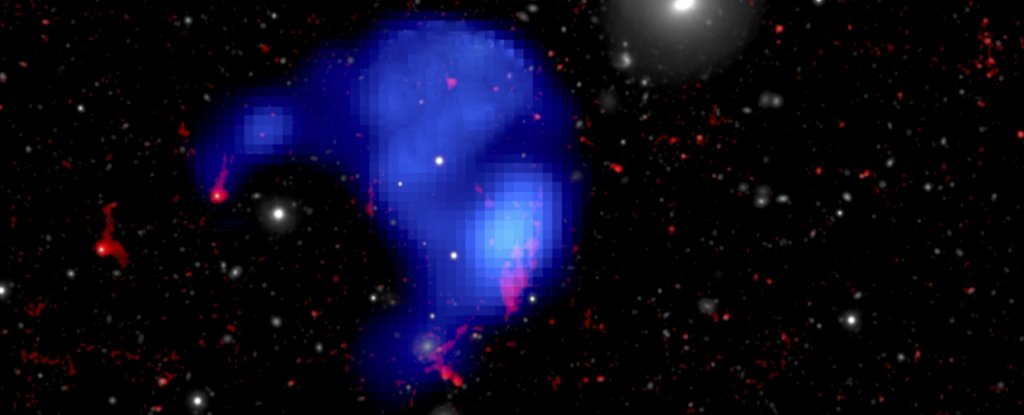Key Takeaways:
- Astronomers discovered a giant gas cloud, larger than Milky Way, floating in intergalactic space.
- The cloud is most likely stripped from a galaxy by the hot gas in the galaxy cluster.
- The magnetic field around the cloud may have kept it together for hundreds of millions of years.
- This discovery helps scientists understand how galaxies lose gas and how matter distributes in galaxy clusters.
- It paves the way for finding more similar gas clouds in the future.

In the yawning vacuum of intergalactic space, something large is lurking.
It’s similar in size, but it’s not a galaxy: a massive gas cloud, larger than the Milky Way, that is hot and faintly glowing and has gathered into a massive cluster in the interstellar medium.
This is the first gas cloud of its kind that has ever been observed, and scientists surmise that it may have been unexpectedly removed from a galaxy in the cluster. Even more surprisingly, it hasn’t dissipated, but has remained clumped together for hundreds of millions of years.
This points to a new direction for the study and comprehension of these enormous structures in addition to providing new information about what lies inside of galaxy clusters.
This is an astonishing as well as an exciting discovery. As the oldest of the natural sciences, astronomy constantly reveals new surprises, as physicist Ming Sun of the University of Alabama in Huntsville showed.
As the name implies, galaxy clusters are collections of galaxies that are gravitationally bound. Our ‘orphan’ gas cloud was discovered in the Leo Cluster, a galaxy cluster known as Abell 1367 that is located approximately 300 million light-years away. At least 72 major galaxies are found in it, and it is a component of a larger supercluster complex.
Astronomers like to look into such environments because they frequently have a lot going on and can help us understand the connections between the universe. Abell 1367 was observed by astronomers in 2017 with Japan’s Subaru Telescope. The object appeared to be a small, warm cloud, but its origin was unknown, so the researchers returned with additional instruments to examine it more closely.
To their surprise, a team led by astronomer Chong Ge of the University of Alabama in Huntsville used Subaru, the Multi Unit Spectroscopic Explorer (MUSE) on the Very Large Telescope, and the ESA’s XMM-Newton X-ray telescope. They also discovered X-ray emission indicating the cloud was larger than they had initially believed.
Much larger, in fact – bigger than the Milky Way galaxy, with a mass around 10 billion times that of the Sun. Furthermore, it did not appear to be connected to any known galaxy within the cluster. It was merely floating by. However, the abundance of data made it possible for the researchers to measure the gas’s temperature, which in turn showed information about where it originated.
The temperature of the cloud is between 10,000 and 10,000,000 Kelvin, which is in line with the interstellar medium, which is gas found inside galaxies. At about 100 million Kelvin, the much hotter intracluster medium—the region between the cluster’s galaxies—is composed of much more tenuous hot gas.
This suggests that the cloud of gas was stripped from a galaxy as it moved through space.
“The gas in the cloud is removed by ram pressure of the hot gas in the cluster, when the host galaxy is soaring in the hot gas with a velocity of 1,000 to 2,000 kilometers [620 to 1,240 miles] per second,” Sun stated.
“It is like when your hair and clothes are flying backward when you are running forward against a strong headwind. Once removed from the host galaxy, the cloud is initially cold and is evaporating in the host intracluster medium, like ice melting in the summer.”
The fact that the researchers were unable to locate any nearby galaxies that could explain why this was happening recently makes this fascinating but also kind of strange. However, this lack of proximity suggested that the gas had been torn from its galaxy hundreds of millions of years ago; if so, how had it not diffused into the intracluster medium?
The team calculated this and discovered that, for extended periods of time, a magnetic field could keep the gas cloud together in the face of instabilities that should otherwise tear it apart.
Given the high mass of the cloud, the team has inferred that the parent galaxy from which it was torn was a large and massive one. This could assist them in determining which galaxy it was; further evidence may come from gas traces that come from the cloud and could indicate the correct direction.
In addition, now that one lonely cloud has been identified, scientists have a set of data that will help to identify other such clouds in the future. This will yield important insights into the distribution of matter in galaxy clusters and the dynamics occurring within individual clusters.
Furthermore, observational evidence now supports the idea that galaxies can lose their gas due to the intracluster medium.
“As the first isolated cloud glowing in both the H-alpha spectral line and X-rays in a cluster of galaxies, it shows that the gas removed from galaxies can create clumps in the intracluster medium, and these clumps can be discovered with wide-field optical survey data in the future,” Sun stated.
The research has been published in the Monthly Notices of the Royal Astronomical Society.


